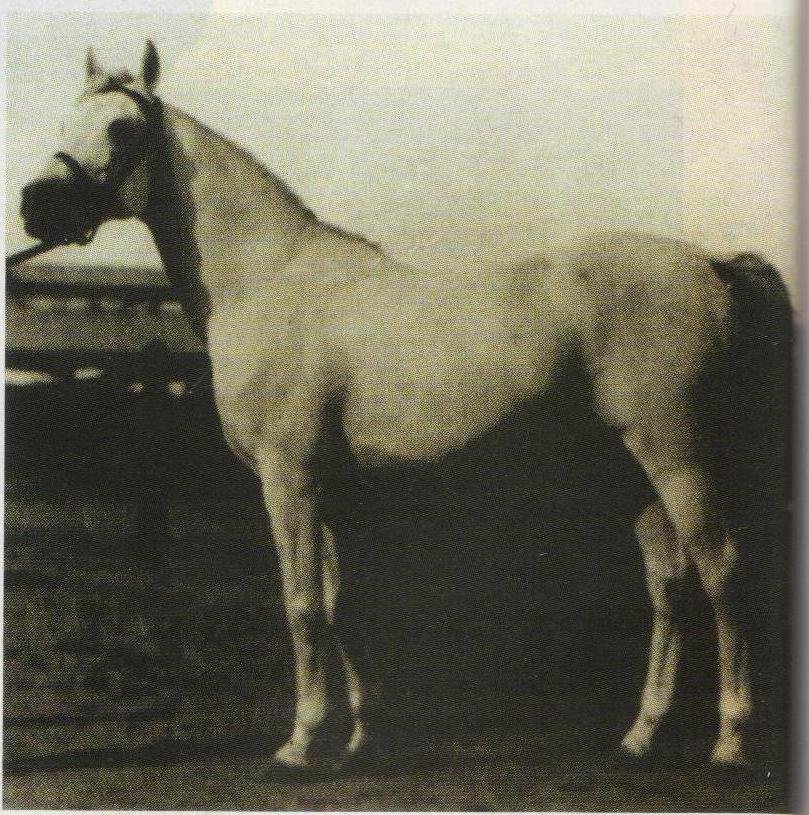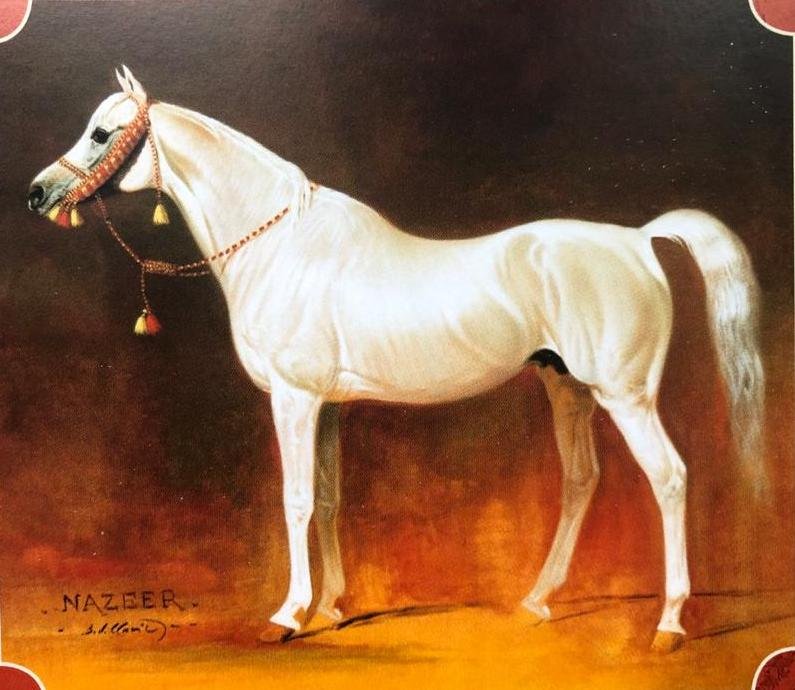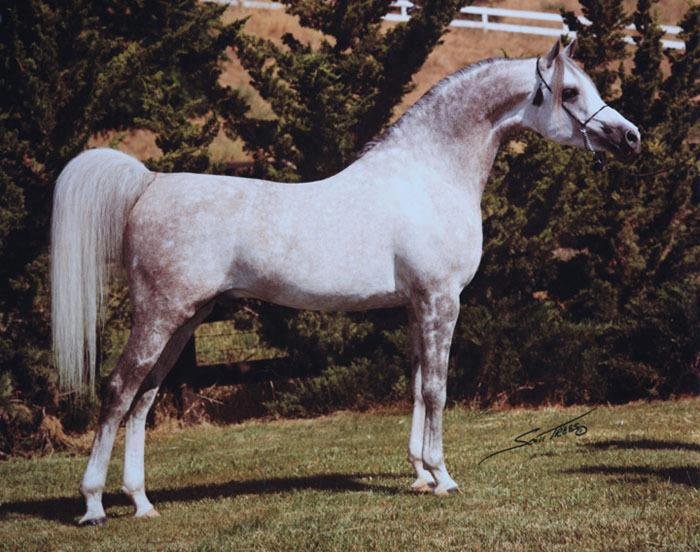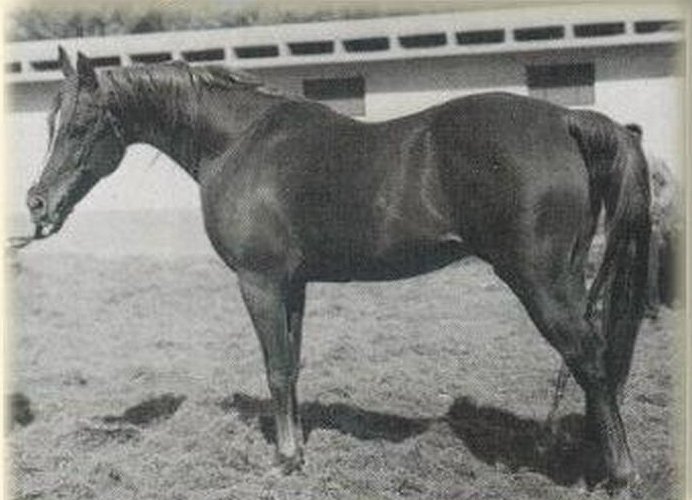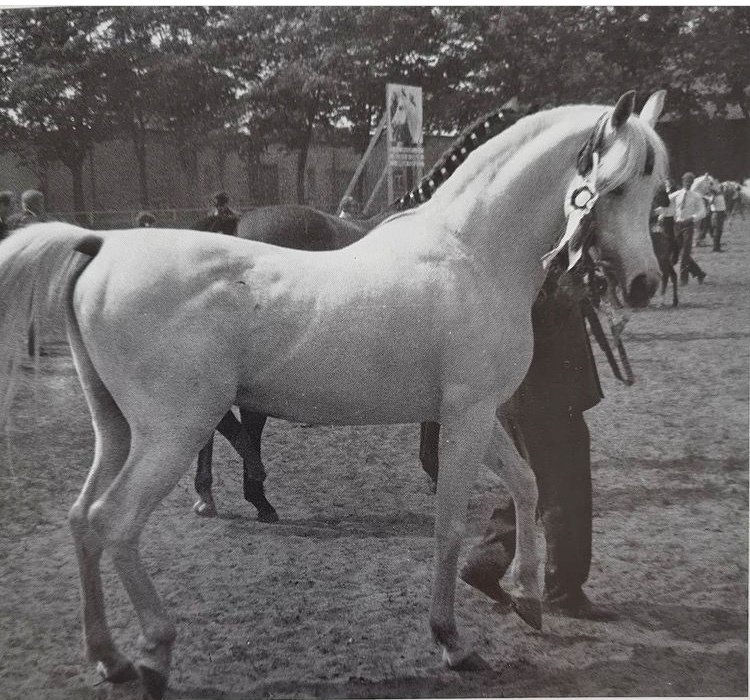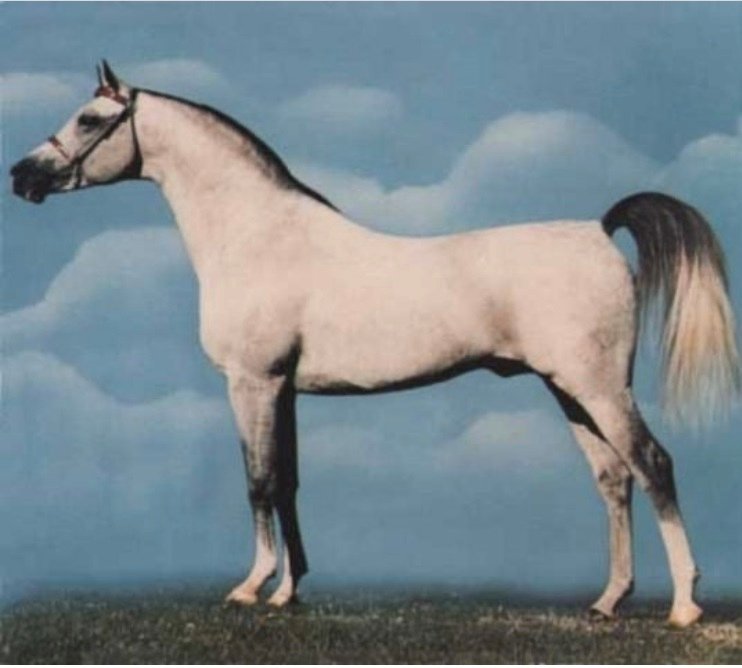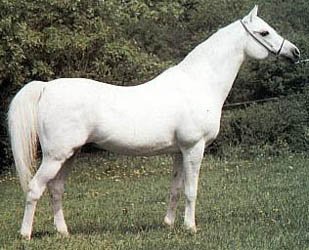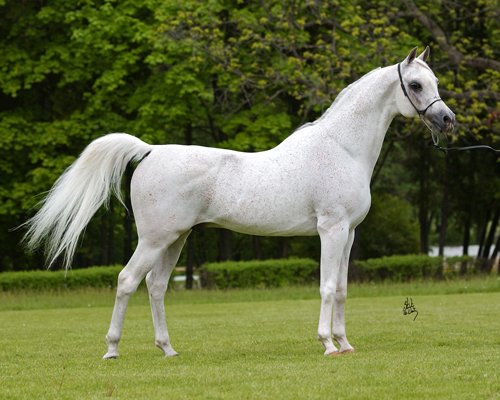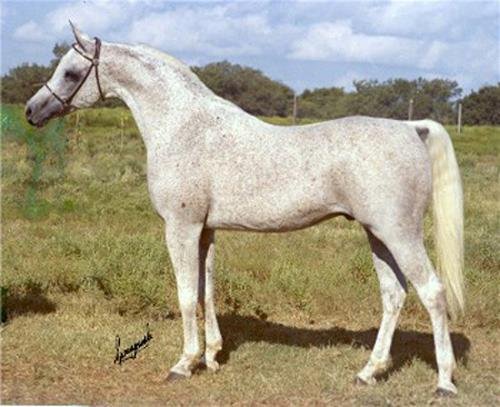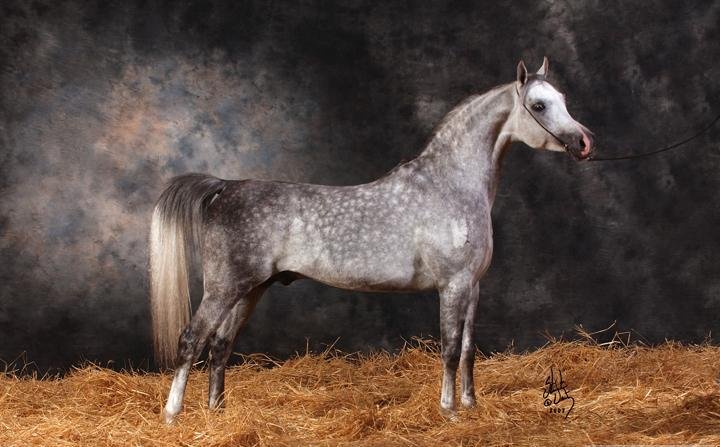Author: Maciej Paweł
Grzechnik
Representatives of the Saklawi I sire line have since long gained a worldwide domination
among sires representing the show type. That sire line started to be widely used in Poland at the
dawn of the third millennium, initially in state owned breeding. As they developed, private breeders
followed. This situation eventually led to spreading opinions that the Polish breeding suffered from
an “overflow” of sires representing the Saklawi I sire line, to the detriment of the small
population of Arabian horses in Poland caused by excessive inbred.
Domination of Saklawi I in
the breeding of Arabian horses in Poland.
After World War II, the Polish breeding of Arabian horses adopted the
principle that breeding was to be conducted within over a dozen dam families and several sire
families considered as Polish. Such approach was supported by a formal regulation to that effect
included in the Polish Breeding Program for the Arabian horse. If the pedigree of dam families of
the Polish mares can be traced as far back as the 18th centrury, though most often to the beginning
of the 19th century, sire families are much younger for a variety of reasons. Repeated disasters
striking the Arabian horse breeding on the territories of Poland caused the necessity to reproduce
the breeding times again from random material, always within a limited population in comparison with
the starting population. Therefore, excessive inbred within a herd was a longtime fear among the
Polish breeders, constantly pushing them in search of new sires. For that very reason, in 1972 Palas
was brought to Poland, a sire representing the Saklawi I line, hitherto unknown in the Polish
breeding of Arabian horses. Initially, the influence of Palas was extremely strong. However, in the
nineties of the 20th century that influence started to abate, eventually to become completely absent
from the Polish horse breeding by the year 2021. Meanwhile, entry of the Polish breeding into the
world current of show horses meant abandoning the Polish way of breeding Arabian horses, paved by
Polish hipplogists before Wold War II, with the aim of making the Polish Arabian horse brave and
beautiful. Instead, horses from the Saklawi I sire line ( represented by Palas) started to occupy
the boxes of frontal stallions in the Polish state studs. This was due to the fact the Saklawi I
sire line dominated the world among show horses. Later on, the semen of stallions from Saklawi I
sire line became the subject of importation by private studs as well. The view that Polish breeding
was inundated by Saklawi I sire line found justification in the number of sires used representing
the Saklawi I line. This, in turn, led to the conclusion that the Arabian horse in Poland was
endangered by excessive inbred. That view is constantly being repeated, therefore, it seems
necessary to scrutinize that sire line in order to find answers to the following questions: how can
we define in a breeding sense the population called Saklawi I and can we speak about the family of
that sire?
The
founder of the line – sire Saklawi I 1886 or.ar.
The founder of the sire line called by his
name – the sire Saklawi I or.ar. was born in 1886 among Beduins Anazeh Ruala and he belonged to a
family called Saklawi Jidran. Imported from Arabia by Ali Pascha Scherifa and then resold to Prince
Ahmed Kemal, Saklawi I finally found home at the stud of Abbas Pasha Hilmi II, where he ended his
days. He left for breeding only 2 daughters and 3 sons. For four generations, his lineage was
basically extended by one descendant only, in turn: Saklawi II – Gamil Manial – Mansour and finally
Nazeer. Thus, the sire line continued by the above mentioned descendants of Saklawi I nominally
could not be called a family.
Gamil Manial
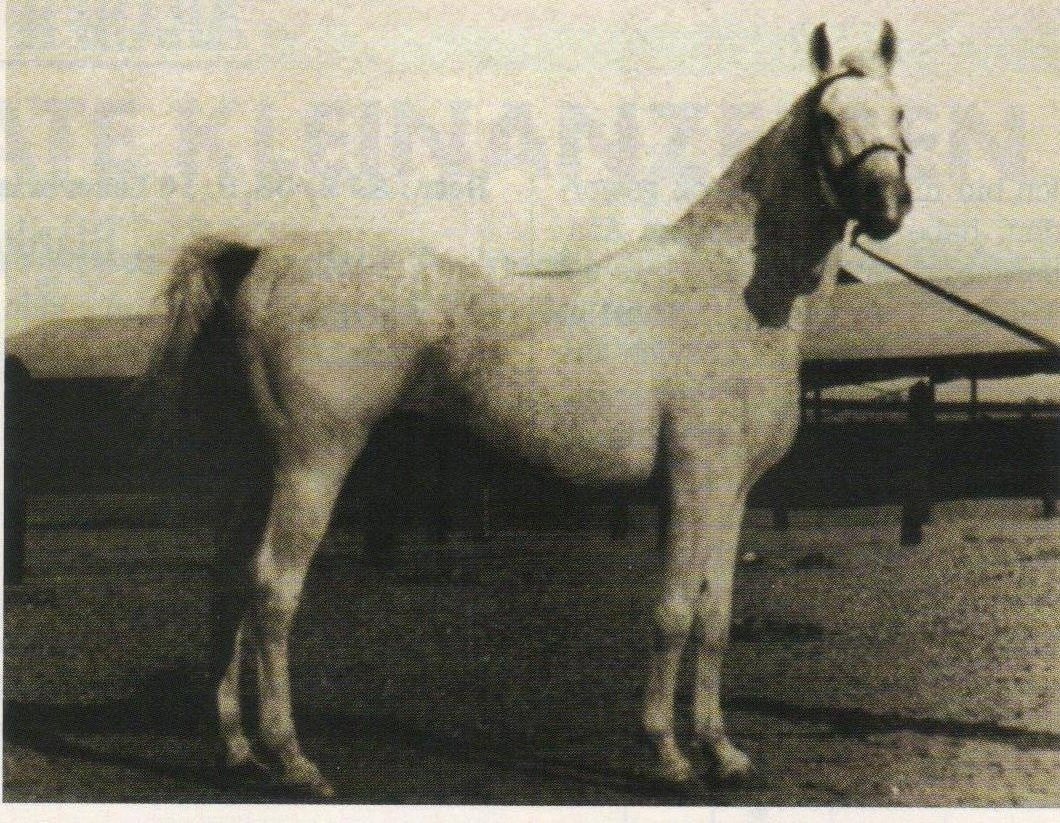
Basically, Saklawi II 1895 (out of El Dahma or.ar.) was given a chance to branch, and thus
to form the family of Saklawi I, as he gave two valuable sons: Mabrouk Manial and Gamil Manial. The
latter eventually prolonged the line that exists till now. The career of the first one, Mabrouk
Manial, is connected with Poland through his son, the stallion Kafifan. Thanks to Kafifan Saklawi I
appeared for the first time in the Polish breeding. In 1924 count Alfred Potocki imported the
stallion Kafifan 1916 ,out of Nigma, to his stud in Beheń. Count Potocki effected that purchase on
his return from safari in Sudan. Kafifan was covering mares not only from Beheń stud, but also from
studs in Gumniska, Pełkiń, Ołyki and Pomorzany. Although Kafifan was characterized by exceptional
beauty, he did not leave any ROnly three of his daughters were incorporated into the herd at Beheń
stud and one of these, Mattaria 1926 was eventually sold to the U.S.A. Two portraits of Lartur
remain till this day in one of the Potocki estates in Łańcut. The sire line Saklawi I was
successfully prolonged by the second son of the stallion Saklawi II, Gamil Manial 1912, out of
Dalal, who gave the valuable Mansour 1921, out of Nafaa El Saghira. There exists an assumption that
Mansour was not a son of Gamil Manial, but of another stallion with a similar name, though
representing a different family than Saklawi I. However, the existing photographic portrait of Gamil
Manial, the first stallion representing that family ever photographed, contradicts that assumption.
The photographic picture clearly shows his weak body (barrel), a feature characteristic for the sire
line Saklawi I. The said feature is very strongly established, and can be observed in contemporary
stallions as well, an example being the known and influential stallion WH Justice.
Mansour
Families and branches of the stallion Saklawi I
The above mentioned
stallion Mansour proved crucial to continued existence of the sire line Saklawi I. Mansour gave two,
highly valuable stallions, Sheikh El Arab 1933, out of Bint Sabah, but first and foremost the
epochal Nazeer 1934, out of Bint Samiha. That descendant of Saklawi I was the first to branch so
widely the line of his ancestor, giving to that family the importance present in contemporary
breeding. Initially, Nazeer was covering in the herds of the Royal Society of Agriculture in Egypt.
It is only at the age of 15 that Nazeer got his real chance thanks to his new breeder, who used him
in the Egyptian state stud Kafir Farouk at El Zahraa. That very breeder who believed in Nazeer was
general Tibor von Pettko-Szandtner, former director of Babolna, expelled from the country by
Hungarian communist authorities.
Nazeer
Nazeer proved to be a sire so immensely important to the breeding of Arabian horses that
his name cannot be found only in very few Egyptian pedigrees. In Egypt itself eleven of his sons
were used. The sons of Nazeer were exported all over the world, becoming everywhere the founders of
very vital families. In all, Nazeer left over one hundred descendants, of which twenty one were used
by breeders in Germany, the U.S.A., U.S.S.R. Until some time, he was appearing very frequently in
the pedigrees of Russian and Polish horses. The success of the American stud Ansata Arabians was
based upon a breeding program with Nazeer as chief sire, onto whom the entire herd was
inbreded.
“King”
Nazeer endowed world breeding with such important stallions as: Hadban Enzahi, Ghazal, Alaa el Din,
Morafic, Ibn Halima, Kaisoon, Galal and the stallion Aswan, of course. The following sons of Nazeer
proved outstanding: Alaa El Din, Morafic and Galal. Alaa el Din
1956 out of Katefa, was used in Egypt. His daughter, Hanan, exported to Germany, became there
the dam of many valuable horses.
Morafic 1956, out of Mabrouk,
sired the stallion Shaker El Masri 1963, out of Zebeda, who was the sire of El Shaklan 1975, out of
Estopa. Morafic was also the sire of the stallion Farag 1962, out of Bint Kateefa, imported to
Babolna stud in 1971, as well as the stallion Ghalion 1965, of out Lubna. Morafic was exported to
USA, leaving in Egypt 58 foals. In the U.S.A., he sired 151 foals, of which 30 became winners of
national championships in the U.S.A. and in Kanada. The pillars of his success as sire are
stallions: grandsons Ruminaja Ali and El Shaklan, followed by Gazal Al Shaqab and his son Marwan Al
Shaqab.
El Shaklan
Galal 1959, out of Farasha, sired Ibn Galal 1966, who was bought by Babolna stud as a
2 years old and subsequently resold to Germany. In the German stud of H.J. Nagel Ibn Galal gave the
stallion Ibn Galal I (DE) 1972. Ibn Galal I was widely used in Babolna, leaving there a number of
outstanding mares.
Galal
Young sons of Nazeer, Hadban Enzahi 1952, out of Kamla, and Ghazal 1953, out of Bukra, were exported in 1955 to the Marbach stud. Apart from the
same origin, year of procurement as well coat colour homozygosity, these stallions were also united
by the breeding program. The idea was to interconnect their daughters: one often covered the
daughters of the other. The most valuable and influential descendents of both these sires originated
from such connections.
Ghazal
Kaisoon 1958, out of Bint Katefa, also exported to Germany, was
very widely used in that country. His grandsons are present till this day in the German
breeding.
Kaisoon
Another son of Nazeer
proved extremely important to world breeding. That son was the stallion Aswan (ex Raafat) 1958, out
of Yosreia. Aswan was imported to Tiersk in 1963, where he produced a number of remarkable
descendants. Russian bred descendants of Aswan that influenced world breeding were: Patron 1966,
Kilimandscharo 1968, Palas 1968, Magnit 1969, Plakat 1970, Marsianin 1971, Antey 1972, Mascat 1975
and Mashuk 1977.
Marsianin
The Polish trace
The Saklawi I sire line, so
widespread and popular worldwide, was completely absent in Poland until the seventies of the 20th
century. However, the fear of excessive inbred within a limited native population of Arabian
purebred horses, counting only several hundred, changed that situation. In 1974 the stallion Palas
1968 (out of Panel by Nil) was bought in Tiersk. Palas, representing the Saklawi I sire line, son of
Aswan and grandson of Nazeer, had a pedigree completely foreign to the Polish breeding. Roman
Pankiewicz wrote that “he was a sire very needed in our breeding.
His completely foreign pedigree (3/4 Egyptian) allowed to use him on a very wide scale in all Polish
studs." (10). Initially, that sire left his imprint on the population of the Arabian horses
in Poland, leaving "...valuable stallions, and even more valuable
mares”. (10).
Palas
He gave very beautiful
descendants out of the most valuable Polish mares. That progeny by Palas won many highest awards,
both at national and international shows. The daughters of Palas brought to the Polish breeding the
expected exotic type, but also many flaws, transmitted by Palas through his progeny, such as a long
barrel (body) and defective legs, mainly frontal. These flaws caused a high level of elimination
from breeding affecting the said progeny.
Ararat
The most valuable son by
Palas was the stallion Ararat 1985 (out of Arra by Bandos).
His dam was exceptionally brave (she won Oaks, Derby and Comparative), as well as exceptionally
beautiful (she became the Polish Senior Female Champion in 1985), but also outstanding as a mother.
Arra came from the family of Mlecha, that gave Bandola 1948 and Bask 1956. The progeny of Ararat
proved outstanding at show rings and brave on racetrack. Emigrant, the beautiful son of Ararat was used in breeding. His dam, Emigrantka by
Eukaliptus became the Polish Senior Female Champion in 1992.
Emigrant
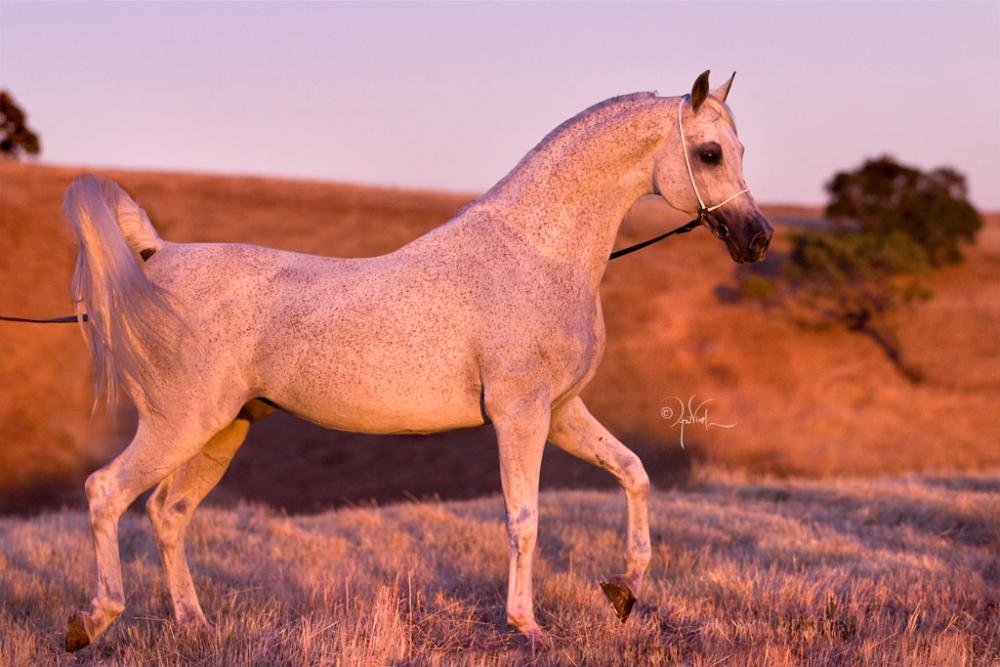
The family of Palas, which
was characterized by great beauty, gave a number of show winners. In the Nations Cup held in Aachen,
Ararat and his son Emigrant competed side by side, winning their respective classes. Another son of
Palas used in the Polish breeding was Endel 1981. He extended the family by one generation giving
the stallion William 1995, the winner of Derby. Even though horses from that family represented a
specific type, perfect movement and even bravery, while the family itself raised justified
expectations as to its further existence, efforts to find next successors and thus to prolong Palas
sire line failed. The only classy son by Emigrant, the stallion Emrod 1997 (out of Emprassa), Polish
Junior Male Champion, was sold abroad without being used in breeding. After the sale of Emrod, also
Emigrant was sold to the U.S.A. without securing a successor to the Polish breeding. So finally,
with the export and subsequent death of Emigrant, that line ended in the Polish breeding.
Endel
The family of Saklawi I
gains supremacy
With the changing requirements concerning the phenotype of horses destined for shows, to
the detriment of their bouquet, so valued in Poland, show rings became a field for display of horses
with Egyptian pedigrees, where the representatives of sire line Saklawi I have been taking the lead
for a long time. Other sire lines were giving way to Saklawi I due to their selection in other
directions than for show purposes.
In Poland: “when the possibility
opened to export the Arabian horses to western Europe and America, preference was given to families
that strengthened features coveted on those foreign markets – mainly show beauty – (…) Since that
time, families in the saklawi type gained advantage in the Polish breeding, as they received better
scores at shows”. Krystyna Chmiel (5).
The aforesaid gave rise to a commonly shared conviction that the sire
line Saklawi I is responsible for eradicating other lines, called native, from the breeding in
Poland. In 2012, also Magdalena Pieszka et al. analyzed the issue of Saklawi I supremacy, concluding
as follows: ”….sire lines and dam lines of Polish Arabian purebred
horses based on their successes on show rings (….). Upon due analyses it was established that among
champions and vice champions the sire lines Saklawi I and Huhailan Haifi, as well as the dam lines
Milordka were definitely predominant." Pieszka (6).
Analyzing the achievements of the
representatives of sire line Saklawi I one has to bear I mind that they are lacking the feature of
bravery, which is reflected in their participation and results in bravery tests conducted on Polish
racetracks. For example, in 2019: ”The best sire of that line –
Pogrom – occupied 16th place in terms of total prize sums won by his offspring, but only 64th place
in terms of average prize sum per one horse.” (8).
Domination of Saklawi I versus Polish state
studs
Presently,
the Polish state studs possess over 600 Arabian purebred horses, of which ca. 200 stud mothers and
young mares to be incorporated. 8 sire lines and 15 dam lines are represented in breeding
(4).
In order to
illustrate the quantitative participation of respective lines, they have been listed in Table I. As
can be inferred, only 4 old Polish sire lines are represented at SKJP (Janów Podlaski stud), along
with Saklawi I that is represented by half of the 20 sires kept there. A much worse situation is
observed at Michałów stud, where as many as 10 out of 12 sires kept there represent Saklawi I. There
remaining two are the aged Ganges – Kuhailan Haifi and the weak Forman – Krzyżyk. Therefore, Table I
only confirms the huge domination of Saklawi I among all sire lines – out of 32 sires kept at state
studs, as many as 20 are representing Saklawi I.
Table 1 Sire
lines in Poland 2019*
Lp | Name of the line | Number of sires
breeding(total) | SKJP | SM |
1 | Kuhailan Haifi or.ar. imp. 1931 do Gumnisk | 2 | 1 | 1 |
2 | Ibrahim or.ar. imp. 1907 do Antonin | 1 | 1 | |
3 | Kuhailan Afas or.ar. imp. 1931 do Gumnisk | 0 | | |
4 | Krzyżyk or.ar. imp. 1876 do Jarczowiec | 1 | | 1 |
5 | Ilderim or.ar. imp. 1900 do Sławuty | 3 | 3 | |
6 | Bairactar or.ar. imp. 1817 do Weil | 2 | 2 | |
7 | Saklawi I or.ar. ur. 1886 w Egipcie | 20 | 10 | 10 |
8 | Koheilan Adjuze or.ar. imp. 1885 do
Babolnej | 0 | | |
9 | Felhaan Alshawaf (BH)** | 1 | 1 | |
10 | Amer or.ar. 1984 (SA)*** | 2 | 2 | |
| Total | 32 | 20 | 12 |
*The Table includes only sires physically present at state
studs
**Saudi Arabia
***Bahrain
Also Marek Trela points to an overwhelming dominance
of sire line Saklawi I: “It is commonly considered that the Polish breeding suffers from an excess
of blood by Saklawi I or.ar. and one can hardly disagree with that opinion. Indeed, wherever you
look, there is Saklawi I everywhere, and that in a variety of combinations, from various studs and
various countries." Thus, we can undoubtedly speak of the so called “overflow”. And yet, to draw the
conclusion thereof that the sire line Saklawi I is harmful finds no justification. Sires
representing that line not only differ largely from each other very often, but also their common
ancestor, Saklawi I, is distant from them by many generations. The sire Nazeer, already very distant
to contemporary horses, possesses only 6,25% of the blood of his progenitor, hence, inbred on him is
not possible. Due to the aforesaid, even a very widespread use of sires so distant genetically from
each other cannot result in incest*. Additionally, attention should be paid to the fact that it is
not the stallion Saklawi I, but only his grand grandson Nazeer who branched the line through his
numerous and valuable sons, thereby creating a sire family so significant in the breeding of the
Egyptian Arabian horses. All the above mentioned aspects give rise to the necessity of responding
anew to the sire line Saklawi I and making a new classification of families with that
line.
*incest – excessive
inbred
Saklawi I line and
families
Possible lack of precision in
defining lines or families considered as Polish is of no practical significance. In contrast, that
is not so with Saklawi, where interchangeable use of the term line or family, in case of such an
expanded line, may lead to a wrong interpretation of reality. In Poland, a huge number of sires
representing the Saklawi I line are groundlessly considered as belonging to the same family. This
leads to the conclusion and fear that the Polish population of Arabian horses is threatened by
inbred due to a widespread use of Saklawi I sires, though in fact these sires are between them quite
foreign genetically. In a genetic sense, Saklawi I was unable to found such a family. Therefore, the
approach to Saklawi I is different in the west, as testified by the classification of the sire line
Saklawi I made by Paraskevas, and also Nagel.
And so, according
to the classification adopted by Paraskevas (6), Saklawi I founded a line called by his name, but
not a family. In view of the existing knowledge about lines and families, such an approach is to be
seen as correct. Apart from Saklawi I, Paraskevas mentions two other sire lines present in the
Egyptian horse breeding, namely Gamil El Kebir and El Deree. This may give the impression that the
Egyptian breeding is very impoverished. And yet, these barely three lines are branched into numerous
families founded by their descendants: Saklawi I created as many as 27, Gamal el Kebir – 16 and el
Deree 8 families. Among families within the sire line Saklawi I, Paraskevas mentions Nazeer, calling
him the King, who left to the world a legacy of his eminent sons, including, of course, Aswan, Ibn
Halima or Morafic. Also Nagel names different families within the sire line Saklawi I, of which the
most important, according to him, were Siglawi Jedran, Kuhailan Rodan, Dahman Shahwan and Hadban
Enzahi (11).
Family tree and affinities between
its representatives
Undoubtedly, the
importance of the highly vital sire line Saklawi I to the breeding of Arabian horses must be
acknowledged. However, that line should not be treated as a uniform collection of horses that could
be termed a family. Within a line, there appeared many stallions significant to the breeding through
their numerous sons and daughters, so their right to found own families, sometimes very distant
genetically, should be accepted. This refers especially to Nazeer, who undisputedly founded a very
branched family. Betty Finke (7) points out that the line in question is often called the Nazeer
line. Furthermore, the quality and importance of his sons justifies the statement that these sons
deserve as well the name of founders of their own families.
The positioning and
frequency of stallions at respective branches of the tree indicate the existence in Poland of the
following sire families within the sire line Saklawi I – Nazeer founded by Nazeer’s sons: Hadban
Enzahi, Ibn Halima and Aswan.
1. Hadban Enzahi
Is the only of
the above families not represented as yet by stallions born in Poland, even though representatives
of that family have been used in Polish breeding: Haytham Albadeia (EG) 2004, Shams Sharaf and Al
Ayed AA.
Hadban Enzahi
2. Morafic
that family occupies an exceptional
position among other families within the line – it is widely represented in Poland through two of
its branches and such stars as Gazal Al Shaqab or El Shaklan. The grandson of El Shaklan, Om El
Belissimo, left in the Polish breeding a son, Barok. Gazal el Shaqab, on the other hand, occupied
the stall of the frontal stallion in the Polish breeding, subsequently frozen semen of his son,
Marwan Al Shaqab was used. In all, Gazal al Shaqab founded a family of great significance to the
breeding.
Morafic
3. Ibn Halima (or Ansata Ibn Halima)
that family
arrived to Poland and is still present there thanks to descendants representing different branches
of the family in question. Laheeb gave the son Poganin, who, in turn, gave Kabsztad. Al Maraam gave
Elmaran and Al Adeed Al Shaqab gave Paladid. The sons of these sires left in Poland have a chance to
prolog the existence of that family.
Ansata Ibn Halima
Poganin
4. Aswan
Initially present in Poland thanks to
Palas, that family is currently very active through another son of Aswan, Padron, exported from
Tiersk to Holland. Descendants of Padron, Padron’s Psyche, Magnum Psyche, but especially Enzo came
to mark the Polish state breeding. The sons of Enzo, El Omari and Empire have been shaping for many
seasons the collection of stud mothers at Michałów. Due to the considerable influence upon the
breeding of stallion Padrons Psyche, with his numerous offspring, both on the sire and dam lines,
one should acknowledge the existence of a family by that stallion. However, neither of the
aforementioned sons of Enzo has managed to produce a worthy male descendant. That refers primarily
to El Omari, a proved sire and father of many outstanding and brave mares, whose only promising son,
Elisario 2018 = was sold without giving him an opportunity to prove himself on track and in
breeding.
Aswan
Patron
El Omari
Grand grandson of Padron and son of WH Justice,
the American sire Sahm el Arab was used in Michałów, though on a limited scale. Apart from a number
of exceptional daughters, he left in Poland the stallion Pointer. Son of Palanga, the eminent
daughter of Ekstern, Pointer has all the prerequisites to prolong that family in Poland, provided he
is not sold.
Table 2 – The families
of sire line Saklawi I – Nazeer in the Polish breeding year 2019
No | Family | No | Stallion | Sire | Stud |
1 | Aswan | 1 | Amanito | Eden C | JP |
2 | | 2 | El Omari | Enzo | M |
3 | | 3 | Empire | Enzo | M |
| | | | | |
4 | Morafic | 1 | Barok | Om El Belissimo | JP |
5 | | 2 | Eryks | Gazal Al Shaqab | M |
6 | | 3 | Pomian | Gazal Al Shaqab | JP |
7 | | 4 | Chimeryk | Eryks | M |
8 | | 5 | Paris | Kahil Al Shaqab | JP |
9 | | 6 | Pistolero | Kahil Al Shaqab | JP |
10 | | 7 | Peon | Kahil Al Shaqab | JP |
11 | | 8 | Pitawal | Kahil Al Shaqab | JP |
12 | | 9 | Morion | Kahil Al Shaqab | M |
13 | | 10 | Pogrom | QR Marc | JP |
14 | | 11 | Equator | QR Marc | M |
15 | | 12 | Medalion | QR Marc | M |
16 | | 13 | Złoty Medal | QR Marc | M |
17 | | 14 | Dastan | Equator | M |
| | | | | |
| Ibn Halima | | | | |
18 | | 1 | Paladid | Adeed Al Shaqab | JP |
19 | | 2 | Poganin | Laheeb | JP |
20 | | 3 | Kabsztad | Poganin | M |
The above tabular approach, with the maternal side (the dam line)
excluded, illustrates the positioning of respective families. Thus the conclusion can be drawn that
the stallions listed are to a large extent distant genetically. Consequently, formal affiliation to
the same line, composed of so many families functioning in the Polish breeding, not single Saklawi I
that are already old, can hardly give rise to any fears of excessive use. Studies conducted by an
international team of scientists, including M. Bugno-Poniewierska and Monika Stefaniuk (13) point to
a low and safe level of affinity within the Polish population of Arabian horses.
Individuals representing
the sire line Saklawi I – Nazeer, but belonging to different families in place since many
generations, cannot be treated as a genetically uniform population. Overlooking the obvious fact
that these families have been developing in different environmental conditions and with different
sets of maternal genes, the decisive criterion is an extremely low percentage of the nearest common
ancestor in the pedigrees of sires used, being Nazeer for the majority of them, not to mention the
sire four generation farther away, i.e. Saklawi I. Comparing pedigrees of two sires vitally
important to contemporary breeding, founders of their own families, as Gazal Al Shaqab and Padron’s
Psyche, differing on the maternal side, allows to draw a simple conclusion that their relationship
factor is low. In case of Padron’s Psyche, his nearest common ancestor with Gazal, I,e, Nazeer
appears four generations back, and even five generations back in Gazal’s pedigree.
Attention should rather be
paid to the fact that that the newly founded family of Gazal, already highly developed, is
represented by as many as 13 of the total 20 stallions, though only some of them are significant in
breeding.
Table 2 also shows a problem facing the Polish breeding, namely inability to produce its
own sire. Only three stallions included in Table 2 have Polish sires, being Chimeryk, Dastan and
Kabsztad.
Summary
The sire line Saklawi I is so called after the name of the stallion, who failed to branch
for four generations and in fact did not found his own family. It is only Nazeer who did that with
success, giving numerous sons, followed by grandsons and further descendants present in breeding
until now. For that reason, the term sire line Saklawi I is not accurate, but rather the term sire
line Nazeer seems more opportune.The sons of Nazeer were so successfully used that they can be
considered as founders of different families within the sire line Saklawi I. Due to geographic,
environmental, but most of all genetic distance of those branches, i.e. different families within
the same line, representatives of those families cannot be treated as a common group of horses.
Thus, Saklawi I is not a family. Instead, in the U.S.A. we have the Morafic or Ibn Halima family, in
Germany Hadban Enzahi, Kaisoon or Alaa El Din , and in Poland only Aswan-Palas family could be
spoken of until recently. Three families within the sire line Saklawi I are now present in the
Polish breeding: Aswan-Padron, Morafic and Ibn-Halima. These very families have dominated the
breeding of show horses in Poland. There exists an apparent trend to found successive families, as
in the case of Gazal Al Shaqab or Pandron’s Psyche. Treating the subject of sire line Saklavi I by
approaching smaller populations within that line may result in analyzing the respective families
from the point of view of shared, intrinsic features characterizing a given family, i.e. a related
group.







